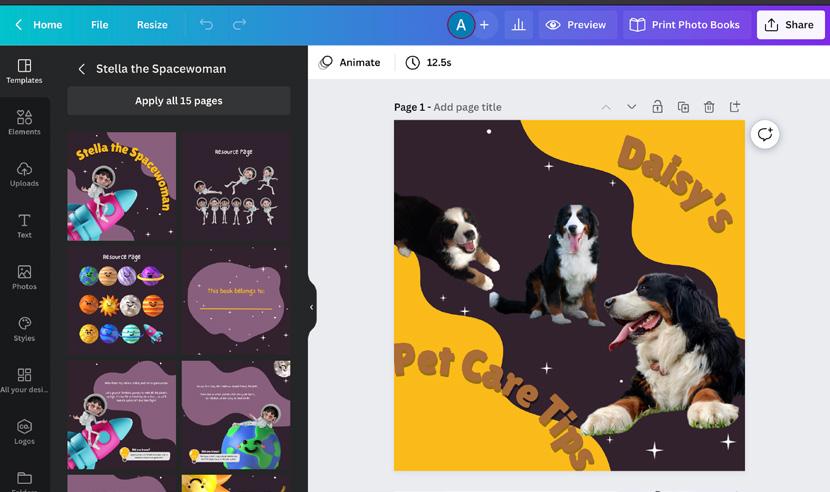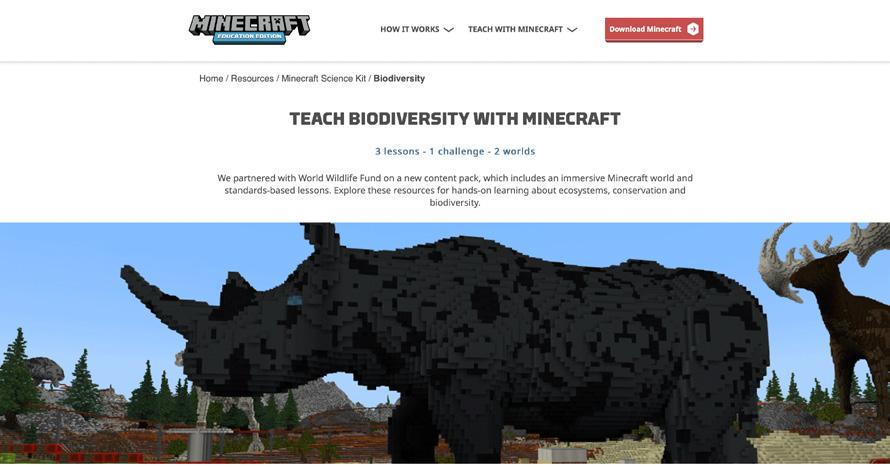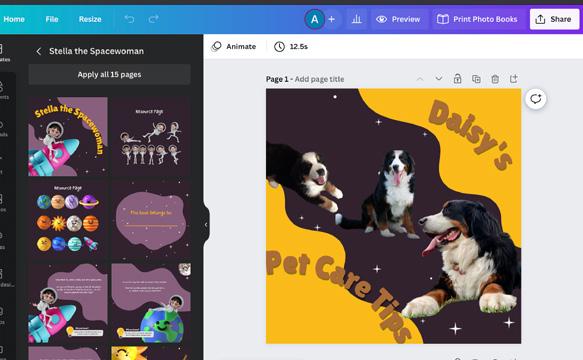a deadly
T4L LOVES ANIMALS!

how data can help save animals

MEET MATILDA!

with a big
and a
a
about an
love
Yvette Poshoglian
CONTRIBUTORS


Joachim Cohen
Sandy Phillips

DESIGN DIRECTOR Anh Ha
T4L Kids is created on Gadigal Land. For more information, visit T4L.link/T4Lkids
HEY THERE T4L KIDS!

Our cute cover star this issue is Matilda the therapy dog! Explore a day in her working life (see pp 6-7). This issue is all about amazing animals. Take the challenge to create an awareness campaign, design a 3D habitat or an infographic to inform others about an animal or species you care about. Don't forget to share your ideas with us! Teachers - don’t forget to explore our teachers’ notes for this issue.


Linda Lazenby Director, Digital Teaching and Learning

Before you start a challenge
Meet Corey Tutt a deadly (brilliant) scientist

from
the

Country,
from
and
in
Explore more
Connect your class with the DeadlyScience club
‘The First Scientists’ – written by Corey Tutt and illustrated by Blak Douglas from



library

Animals and tech in the news
Join the BioBlitz

Become a citizen scientist, connect with nature and take part in the BioBlitz across the southern hemisphere in October! Grab your camera, survey your area for animals and record your findings with others. Talk to your teacher to get started.
Take the BioBlitz challenge!
Check in to a seahorse hotel
White’s Seahorses living in Sydney Harbour are critically endangered. Scientists have built ‘hotels’ for the seahorse colonies to live in. The hotels look like cages and are fully biodegradable, placed close to existing natural habitats. Corals, sponges and algaes grow over the hotels over time, creating artificial reefs for the seahorses to live and thrive in. Could you design a seahorse hotel? See Challenge 2.
Learn about White’s Seahorse

Do your ‘bit’ and spot the species

Could you program a micro:bit to help record data on local species in your school community? Create a simple algorithm and create a micro:bit species counter to log data about animal species in your community.
Take the species micro:bit challenge

Save the dunnart
Kangaroo Island dunnarts on South Australia’s Kangaroo Island need our help! The Black Summer bushfires nearly wiped them out, and now the tiny marsupials are under attack from feral cats. Could you design a cat-proof habitat that protects dunnarts?


Learn more about little dunnarts
Spot the penguins
Every sunset, Little Penguin ‘rafts’ (groups) emerge from the beach at Phillip Island, Victoria and head for their burrows. Follow their progress on camera and join the expert rangers who make a nightly count on livestream every night.
Little Penguin fact file
Listen to the chickens!
Artificial intelligence (AI) can help determine – with up to 97% accuracy –when farmed chickens are in distress. Millions of chickens are farmed in massive sheds around the world and this technology could provide better welfare support for chickens and other farmed animals.
Read more about the chickens – could you design an app?
Work with wildlife!
Do you dream of working with animals?
Taronga Zoo has options for you to explore if you’re investigating zookeeping or other jobs with animals. Brainstorm a list of different jobs with animals and the kinds of skills you might need to work with them.
Explore Taronga Zoo’s internship and student opportunities

Design a pet prosthetic
Pet prosthetics for animals with missing limbs can be designed and printed to help our fourlegged friends get around. Could you design a 3D prosthetic for an animal in need of help? Think about the height, weight and size of the animal and how it could best support the type of animal you’re helping.
Read more about prosthetic animal limbs
Devil of a tumour
Tasmanian Devils today are dying from a disease called Devil facial tumour disease, which scientists are trying to find a cure for. In good news, zoologists and scientists are following a protected colony who don’t have the terrible disease, so hopefully a cure can be found, and this group of Tassie Devils can be protected.
Learn more about the Save the Tasmanian Devil Program

Explore Taronga Western Plains Zoo in 360°
Setonix, supernovas and supercomputers

Quokkas (Setonix brachyurus) are the smiley little creatures native to the West Australian coast. Setonix is also the name of CSIRO’s new supercomputer crunching data from space. Based in Wajarri Yamatji Country in Western Australia, Setonix is in its first phase of release and its data so far has been able to create the image of a supernova remnant!
See more with Setonix and learn more about supercomputers with T4L’s Totally Tech
Create an animal ebook

Do you have a 360° camera kit at your school? Could you capture your school or native habitats on your school grounds with a 360° camera? Check out Taronga’s Western Plains Zoo via a 360° camera.

Check out the expedition here
Budding authorswant to learn how easy it is to create a picture book about your own pet or an interesting animal? Watch the T4L team create a book about Daisy the Bernese Mountain Dog using a Canva storybook template. Watch the workshop here!

Meet Matilda a dog with a big job (and heart)
My name is Matilda and I work every Friday at Hornsby North Public School. I’m a Taloodles therapy dog. Join me for a day in my working life!


8:15am
8:40am
8:50am
Matilda’s diary


yraid
s’adlitaM
I love playing with my buddies (and tennis balls!)
My first meeting of the day is with the teachers – I get lots of cuddles and plan the day ahead with students.
Catch-up time with my mates at the front gate, welcoming them to school. Lots of students live in apartments and don’t have pets.
Put my working dog harness on and grab a quick drink of water. I’ve done a lot of training to get to wear my special harness.
9:00am Year 4 time is busy! I support students who are working, visiting them at their desks. My main job here is to promote happiness and wellbeing.
11:15am
Time to help my special friend in Year 3 with different needs. This morning we’re doing classwork together. We’ve spent a lot of time getting to know each other.
11:50am Water break and snack time (cheese today).
12:00pm
Assembly time! I sit with students who need assistance with focusing.
12:45pm I visit my rest spot and take a little break.
1:00pm
Time to visit my buddies in Kindergarten, Year 1 and Year 2.
2:00pm
3:00pm
3:30pm
Playing Uno is a challenge!
Playing sport with my Year 2 friends is PAWESOME! They find sport a bit difficult, but I try to make it fun!
It’s the end of the school week! I say goodbye to my friends until next week and wag my tail extra hard when I meet parents and carers.
Time to take off my working harness and put on my regular collar. My trainer (and mum), Sue from Taloodles, picks me up from school – time to head home to my family!
Did you know?

Tamarukes like Matilda are happy, loving, intelligent and loyal – making them great therapy dogs
Therapy dogs are trained to help students with special needs
Studies show that dogs bring joy, and help with depression and loneliness
Therapy dogs like Matilda require continued training even once they are working
Furry friends on film!
The students at Hornsby North made a great short film about Matilda – could you make one about a therapy animal at your school, or an animal close to your heart? Check out our challenge on page 10 for all the resources!


 Promoting happiness and wellbeing is part of the job
Promoting happiness and wellbeing is part of the job
Meet Microlight Milly a zoologist with a bird’seye view


Milly Formby is a zoologist on a mission! Milly is also a pilot and the illustrator of a new picture book called A Shorebird Flying Adventure. Her favourite birds are migratory shorebirds and Milly is currently flying around Australia in her microlight plane following the shorebirds with her own birds-eye view.
Together with writer Jackie Kerin, you’ll follow the shorebirds on their migration as they journey to the Arctic tundra and back. Filled with fascinating facts about birds like E7 – the bar-tailed godwit which set a world record for the longest non-stop flight, this book is full of information and great pictures about the shorebirds, their habitats and facts and figures about their incredible journeys.Explore more

Join Milly on her Wing Threads journey around Australia following, the shorebirds up in the air in her microlight aircraft! Teachers can find out more about the book here Want to learn more about Milly and discover how to put together a non-fiction narrative like A Shorebird Flying Adventure? Watch our special T4L workshop here.


Meet Max Hamilton artist and picture book illustrator
Max Hamilton is an artist and the illustrator of award-winning picture books, many of them featuring Australian native animals. Max tells us a little bit about her artwork in her new book with writer Claire Saxby, Tasmanian Devils.

T4L: Hi Max! How did you approach illustrating this book?
MH: I was honoured to illustrate Claire Saxby’s text. I really wanted to show devils in their natural environment.
T4L: Do you draw by hand or digitally, or a combination of both?

MH: When I am illustrating children’s books, I create the illustrations entirely by hand using watercolour paints, coloured pencils, lead pencils and sometimes aquarelle crayons. When I am creating textile designs and logos for clients, I use a combination of hand-drawn illustrations and software such as Adobe Illustrator and Adobe Photoshop.
T4L: Do you have any tips for drawing Tasmanian devils, or their babies – called imps?


MH: Illustrate each devil with different white markings to differentiate between each devil in your story. I used lots of other colours besides the obvious black and white to illustrate the devils such as pink, ultramarine blue, purple and tan. With all the animals I illustrate I do lots of preliminary sketches and drawings of the animal to get to know the body shape and characteristics.
T4L: Which animal would you like to illustrate next?
MH: A greater glider would be fun to illustrate. They have to be one of the cutest Australian animals I have ever seen!
Explore more
‘I used mainly watercolour with coloured pencil and aquarelle crayons to add texture, foliage and detail. When illustrating picture books, it is important to leave lightly coloured areas and enough room for the book designer to place the text.’
Teachers – find classroom ideas here. Kids – try a drawing workshop with author and illustrator Matt Stanton and the T4L team!

Challenge 1 Campaign for animals!
Brainstorm your ideas with your class or group and identify what animal or group of animals you want to focus on.
Australian animals, endangered animals, pets, interesting animals!



Kookaburra



2
Could you collect data or information from your class?
Can you design a poster, create a picture book or create a short film about an animal you love or an animal that needs your help?
Do you need to take a class survey to collect data on your animal? Do you need to observe your pet or local wildlife or collect data from your neighbourhood?
Decide on the most important messages to share about your animal for your poster, picture book or video.
-
What important information do you want to share? Do you want your reader or viewer to take action? What are your key words for action and key images to share?
Brushtailpossum


Top resources to create and build animal awareness




Create an
try the
of
Design a nonfiction picture book with this

get your
in Canva
to
and
Learn
with
a



B ui l dahollow for a brushtail possum

Can you design a 3D habitat for animals?
1. Research habitats of endangered species or animals that you may have seen at the zoo that might need a different enclosure. If you have a pet, you might also want to redesign its habitat at home!
3. Share your design - could you print your habitat in 3D with your school’s 3D printer?

2. Build your design using TinkerCad (for primary students) or 3D Builder (secondary students) or try building in Minecraft: Education Edition.
4. Capture your design as an image or video, and share your ideas behind the design with your class (or us!).
Tips for 3D design
What type of animal is your habitat designed for?
How will they enter and exit their habitat?
What do they keep inside their habitats? Is there enough room inside for food and family?
Did you know?
Parakeets, lorikeets and cockatoos live in tree hollows

Tasmanian devil imps (babies) live in borrowed burrows
Pademelons, which are native to Tasmania and belong to the kangaroo family, live in the bush amongst dense eucalyptus.
Could you design a prosthetic limb for an animal missing a leg or paw?
Top








Challenge 3
Design an animal infographic
1Are you interested in collecting data about animals either in your backyard or on another continent? Could you compile observations and information about your pet?
2Use Google Forms or Microsoft Forms to create a survey among your classmates or school. Record data you find by observing animals using Excel, Google Sheets or Numbers. You could also jump online and see what you can discover about an animal you are passionate about.
Thorny devil
3What does the data you have collected tell you about the animals you’re researching? How could you share this information with your class and community to build awareness?
Kitten
Working with data
If you’re observing your pet, your findings could help you better understand their needs. How often do they need to be walked or go outside? How much water do they require? How often and how much do they eat?

Are you surveying wildlife in your local area like birds or lizards? How will you find your data? Could you get your class or the whole school involved?

The type of data you’re collecting will help you decide how you’ll tell your data story.
If you’re surveying endangered animals, you could build an awareness campaign ( try Challenge 1 ) .
 Australian Kelpie
Eastern Australian water dragon
Australian Kelpie
Eastern Australian water dragon
Top
for













